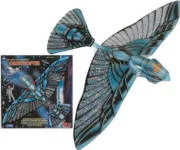Serving the worldwide community of radio-electronic homebrewers. Providing blog support to the SolderSmoke podcast: http://soldersmoke.com
Podcasting since 2005! Listen to Latest SolderSmoke
Saturday, January 21, 2023
My HI7/N2CQR QSL Card
A Call for Builders! Please help us Test this Receiver! Please Build this Receiver!
This is the Direct Conversion receiver that Dean and I have built. We plan to have students at a local high school build it, starting in early February. We would like to have some others build it, to make sure that the design is re-producible without problems.
Please build this receiver! But we ask that you build it exactly as per the schematic above and below. Innovation can come later -- for now we just want to make sure this thing works, that there are no errors in the schematic, and that it can be built by the students with minimum woe. Thanks in advance!
Dean or others with 3D printers may be able to supply the plastic form for the PTO inductor.
We know of one other builder, but he is having some trouble. We would like to confirm that this design is sound.
-------------------
Here is a larger image of the schematic (click for a full view):
Friday, January 20, 2023
Open Circuits: The Inner Beauty of Electronic Components
I was not going to buy this book. But then, Elisa and I were in a book store and there it was. I decided to take a look. I opened it to a random page: 2N3904. TRGHS. Sold.
It is really interesting.
You can order yours through the Amazon Search block in the right side column of the blog.
Tuesday, January 17, 2023
SolderSmoke Re-Play: Goggle EMBRACES Morse Code: Gmail Tap
A True Measure of a Jean Shepherd Fan: Did You Fly One of His Ornithopters?
Sunday, January 15, 2023
Working Walter KA4KXX from Hispaniola
Walter KA4KXX in Orlando has been a prolific builder of rigs for many years, and has been a great friend of SolderSmoke: Here are some of the SolderSmoke podcasts and blog posts in which Walter's solder melting was mentioned: https://soldersmoke.blogspot.com/search?q=KA4KXX
As we approach the end of our current stay in the Dominican Republic, I could not miss out on the chance to work Walter with his homebrew rigs. Even though the space weather was stormy, and my dipole was droopy, we arranged to meet up on the high end of the 20 meter CW band this morning. See the results in the video above. A solid QSO with Walter. He says it is HB2HB, but truth be told I was on a uBITX that was built more by Farhan than by me. But this was a great contact. Walter started with a 50W rig, then switched to his 3 watt rig with a DC receiver. FB
Here is the e-mail I received from Walter after the QSO:
Dear Bill:
Working Vienna Wireless Society member (KA4CDN) from Hispaniola
Thursday, January 12, 2023
On Ten Meters with a uBITX from the Eastern Tip of Hispaniola
Tuesday, January 10, 2023
SolderSmoke Re-Play: Shep tries to build a Heising Modulator -- Shep on Parasitics and Troubleshooting: "That way madness lies"
You guys really have to listen to this. This is culturally important.
In this 1965 radio broadcast, Jean Shepherd describes his teenage struggles with parasitics and other technical problems in his homebrew 160 meter transmitter.
He describes the sound of parasitics on a signal, saying that they sound as if the signal is being attacked by "debauched erotic locusts."
He really nails it in describing the scornful, dismissive tone that many hams use in telling their fellow radio amateur that there are problems with his signal. ( I have recently been on the receiving end of this kind of treatment.)
He observes that no one is more worried, "than a man who has built something and can't get it to work." Indeed.
During a date with a girl from his high school, he is so obviously preoccupied with his transmitter trouble that she tells him that something is wrong with him and that his mother "should take him to a doctor."
And he describes the joy that comes when you figure out the problem and get the thing to work.
The REALLY good stuff begins at about the 25 minute point.
http://ia310115.us.archive.org/2/items/JeanShepherd1965Pt1/1965_01_29_Ham_Radio.mp3
Shep was quoting from King Lear: "O, that way madness lies; let me shun that; No more of that." In other words: "BASTA!"
EXCELSIOR!
Monday, January 9, 2023
Other Workshops: Building a Flying 21:1 Scale Airbus A-380
Arnie Coro CO2KK -- Homebrew Hero -- Silent Key
I was sorry to read this morning of the passing of Homebrew Hero Arnie Coro CO2KK. As we see in one of the obits, Arnie got his start in radio at age 12, with the gift from his father of a chunk of galena, a coil, and some headphones.
Here are some of the SolderSmoke posts about Arnie:
https://soldersmoke.blogspot.com/search?q=CO2KK
He will be missed.







